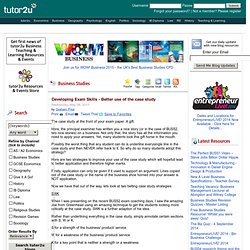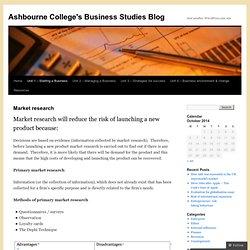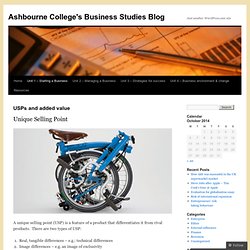

BUSS1 Basics. BUSS 1 In a nutshell. Developing Exam Skills - Better use of the case study. Wednesday, May 08, 2013 PrintEmailTweet This!

Save to Favorites The case study at the front of your exam paper. A gift. Here, the principal examiner has written you a nice story (or in the case of BUSS2, two nice stories) on a business. Possibly the worst thing that any student can do is underline everysingle line in the case study and then NEVER refer back to it. Here are two strategies to improve your use of the case study which will hopefull lead to better application and therefore higher marks. Firstly, application can only be given if it used to support an argument. Now we have that out of the way, lets look at two belting case study strategies: When I was presenting on the recent BUSS2 exam coaching days, I saw the amazing Joe from Greenhead using an amazing technique to get the students looking more critically at the case study.
Rather than underlining everything in the case study, simply annotate certain sections with S, W or K. Sole trader or limited company: the best choice for freelances. One of the most common questions asked by the self-employed is whether to trade as a company or as an individual.

The decision has implications for tax, legal and financial responsibilities, the amount of paperwork you will need to complete and how your peers view you. There is no straightforward answer, because different legal structures suit different situations. ClearSky Accounting in Warrington works with both structures and often advises individuals about which path to take. Daniel Mepham, its business and development director, advises: "Once you have decided to be your own boss, you then need to choose the best structure for your business.
This decision should be made at the outset, before you begin trading. "The structure you choose can depend on your own personal situation and future plans, therefore the decision you make will have an impact on how you pay the relevant tax to HMRC. " "Picking the wrong structure could see you paying more tax than is necessary," explains Mepham. Grade Boundaries for BUSS1, BUSS2, BUSS3 and BUSS4. We've had lots of students and teachers ask us what the grade boundaries were for the four AS / A2 units in summer 2014.

The details are below. Grade boundaries vary from sitting to sitting, though they give a good indication of required performance for target grades. Scaled Mark Grade Boundaries (out of 60) in 2014 were: A (41) B (36) C (32) D (28) & E (28) tutor2u series: BUSS1 Exam Technique Advice. Bee Business Bee - Business Studies Resources for Teachers and Students.
Ashbourne College's Business Studies Blog. Definition: Market segmentation is when a firm breaks up its market (its customers) into smaller groups (segments) that share similar characteristics.

They will then target different products at different segments. Example – How Nike segments the sports clothing market: genderreligionageinterest/lifestyleincomeoccupationsocial classnationalityethnicitypolitical beliefs Task 1. 2. Segmentation by social class. Ashbourne College's Business Studies Blog. Decisions are based on evidence (information collected by market research).

Therefore, before launching a new product market research is carried out to find out if there is any demand. Therefore, it is more likely that there will be demand for the product and this means that the high costs of developing and launching the product can be recovered. Primary market research Information (or the collection of information), which does not already exist that has been collected for a firm’s specific purpose and is directly related to the firm’s needs. Methods of primary market research Questionnaires / surveysObservationLoyalty cardsThe Dephi Technique Secondary market research Information (or the collection of information), which has already been collected for another purpose by someone else.
Ashbourne College's Business Studies Blog. Unique Selling Point A unique selling point (USP) is a feature of a product that differentiates it from rival products.

There are two types of USP: Real, tangible differences – e.g.: technical differencesImage differences – e.g. an image of exclusivity A USP will add value so allows the firm to charge more. Adding value Added value Definition – The difference in a value between the price of the finished product and the cost of inputs. AQA Business Studies for AS - Chapter 2 - Sturridge & Gillespie. Chapter Four Developing Business Plans. Chapter Five Conducting Start Up Market Research doc. Chapter Eight Raising Finance. Chapter Eleven Calculating Costs, Revenues and Profits. Chapter Fifteen Assessing Business Start Ups.
GCSE Bitesize: Breakeven point.